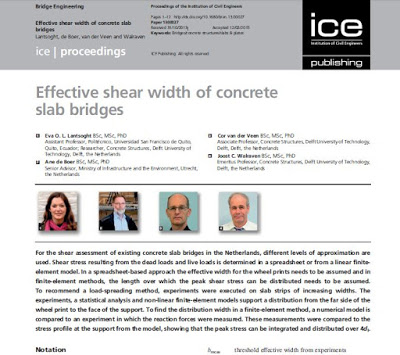Effective shear width of concrete slab bridges
My coauthors and I recently published a paper in ICE (Institute of Civil Engineering) – Bridge Engineering. This publication is our first in this journal. The work is based partially on the 7th chapter of my PhD thesis, and extended with some additional research that Dr. de Boer and I worked on.
The abstract is as follows:
For the shear assessment of existing concrete slab bridges in the Netherlands, different levels of approximation are used. Shear stress resulting from the dead loads and live loads is determined in a spreadsheet or from a linear finite element model. In a spreadsheet-based approach the effective width for the wheel prints needs to be assumed and in finite-element methods, the length over which the peak shear stress can be distributed needs to be assumed. To recommend a load-spreading method, experiments were executed on slab strips of increasing widths. The experiments, a statistical analysis and non-linear finite-element models support a distribution from the far side of the wheel print to the face of the support. To find the distribution width in a finite-element method, a numerical model is compared to an experiment in which the reaction forces were measured. These measurements were compared to the stress profile at the support from the model, showing that the peak stress can be integrated and distributed over 4dl.

